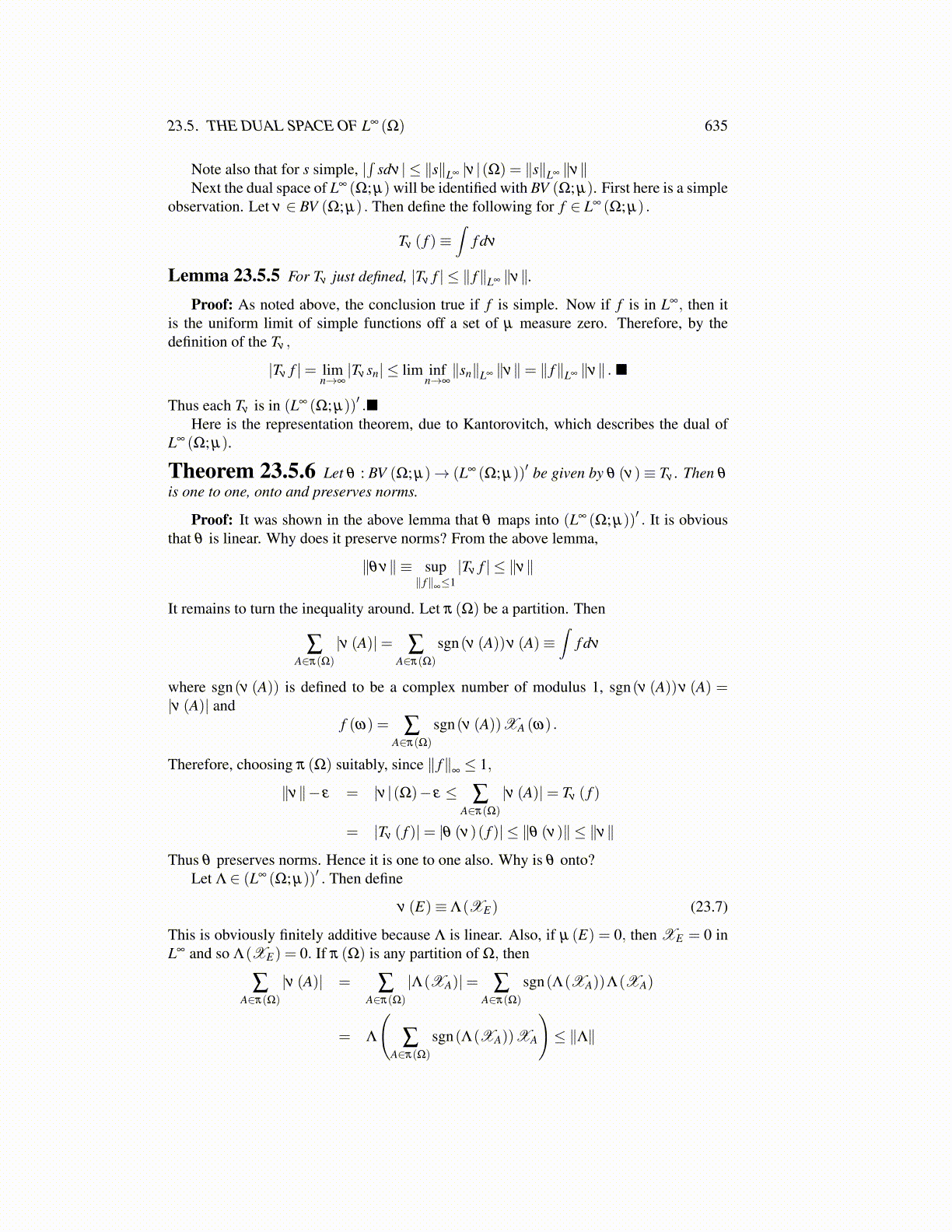
23.5. THE DUAL SPACE OF L∞ (Ω) 635
Note also that for s simple, |∫
sdν | ≤ ∥s∥L∞ |ν |(Ω) = ∥s∥L∞ ∥ν∥Next the dual space of L∞ (Ω; µ) will be identified with BV (Ω; µ). First here is a simple
observation. Let ν ∈ BV (Ω; µ) . Then define the following for f ∈ L∞ (Ω; µ) .
Tν ( f )≡∫
f dν
Lemma 23.5.5 For Tν just defined, |Tν f | ≤ ∥ f∥L∞ ∥ν∥.
Proof: As noted above, the conclusion true if f is simple. Now if f is in L∞, then itis the uniform limit of simple functions off a set of µ measure zero. Therefore, by thedefinition of the Tν ,
|Tν f |= limn→∞|Tν sn| ≤ lim inf
n→∞∥sn∥L∞ ∥ν∥= ∥ f∥L∞ ∥ν∥ . ■
Thus each Tν is in (L∞ (Ω; µ))′ .■Here is the representation theorem, due to Kantorovitch, which describes the dual of
L∞ (Ω; µ).
Theorem 23.5.6 Let θ : BV (Ω; µ)→ (L∞ (Ω; µ))′ be given by θ (ν)≡ Tν . Then θ
is one to one, onto and preserves norms.
Proof: It was shown in the above lemma that θ maps into (L∞ (Ω; µ))′ . It is obviousthat θ is linear. Why does it preserve norms? From the above lemma,
∥θν∥ ≡ sup∥ f∥∞≤1
|Tν f | ≤ ∥ν∥
It remains to turn the inequality around. Let π (Ω) be a partition. Then
∑A∈π(Ω)
|ν (A)|= ∑A∈π(Ω)
sgn(ν (A))ν (A)≡∫
f dν
where sgn(ν (A)) is defined to be a complex number of modulus 1, sgn(ν (A))ν (A) =|ν (A)| and
f (ω) = ∑A∈π(Ω)
sgn(ν (A))XA (ω) .
Therefore, choosing π (Ω) suitably, since ∥ f∥∞≤ 1,
∥ν∥− ε = |ν |(Ω)− ε ≤ ∑A∈π(Ω)
|ν (A)|= Tν ( f )
= |Tν ( f )|= |θ (ν)( f )| ≤ ∥θ (ν)∥ ≤ ∥ν∥
Thus θ preserves norms. Hence it is one to one also. Why is θ onto?Let Λ ∈ (L∞ (Ω; µ))′ . Then define
ν (E)≡ Λ(XE) (23.7)
This is obviously finitely additive because Λ is linear. Also, if µ (E) = 0, then XE = 0 inL∞ and so Λ(XE) = 0. If π (Ω) is any partition of Ω, then
∑A∈π(Ω)
|ν (A)| = ∑A∈π(Ω)
|Λ(XA)|= ∑A∈π(Ω)
sgn(Λ(XA))Λ(XA)
= Λ
(∑
A∈π(Ω)
sgn(Λ(XA))XA
)≤ ∥Λ∥